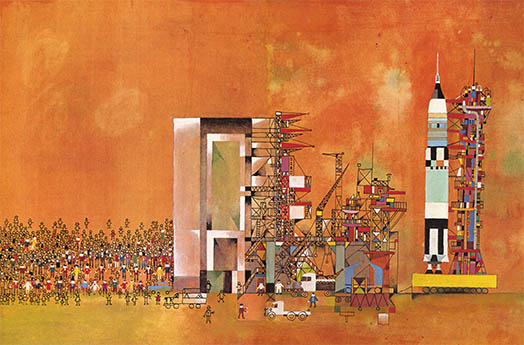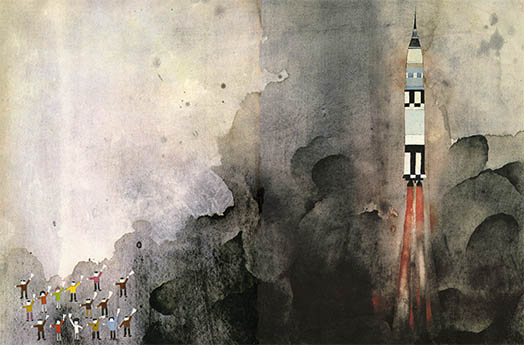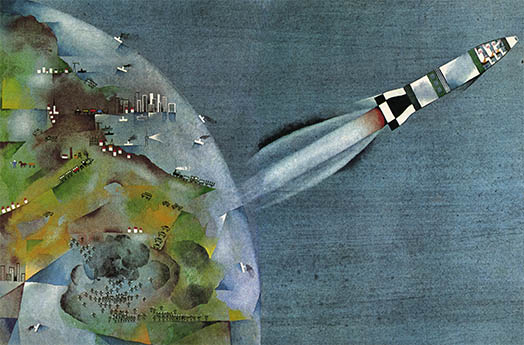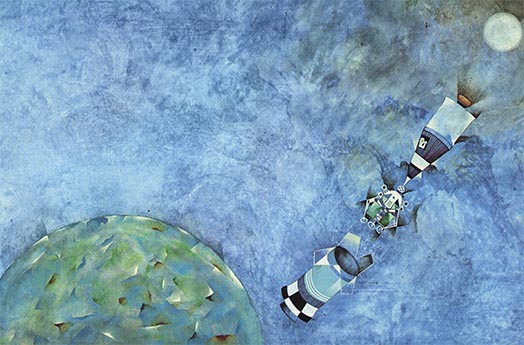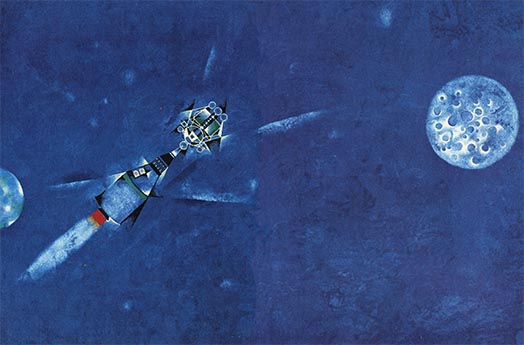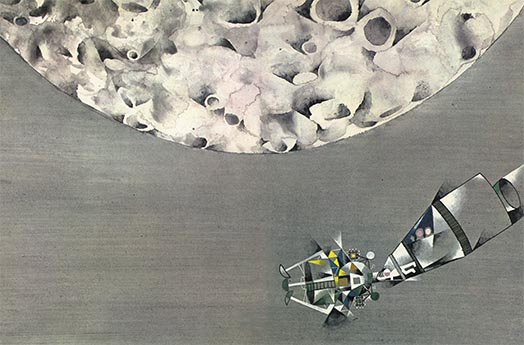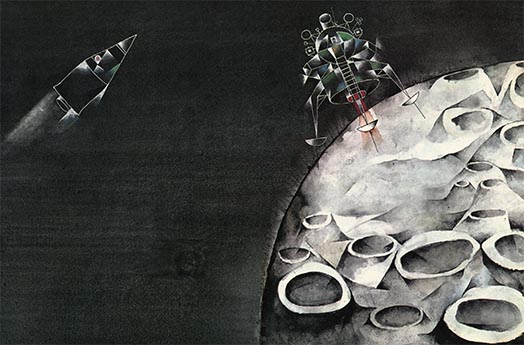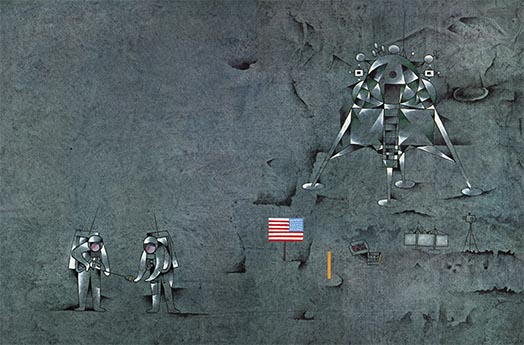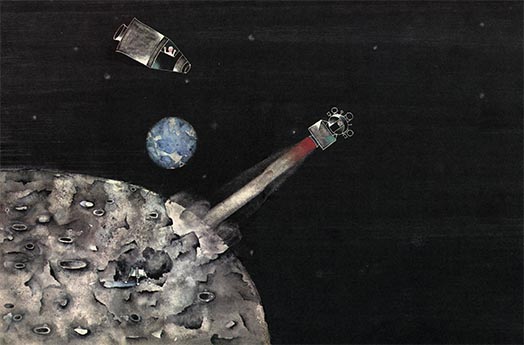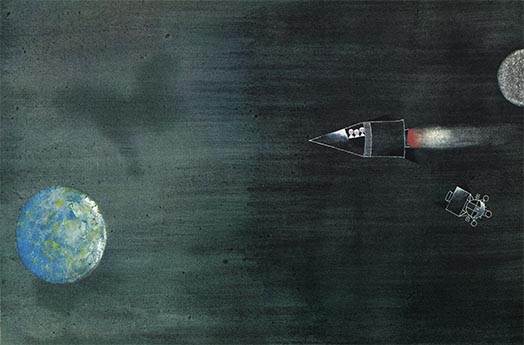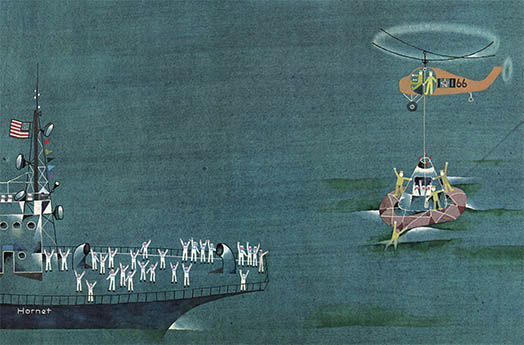34
Hier Apollo 11
Exactly 40 years ago today Neil Armstrong, commander of Apollo 11, became the first person to step foot on the moon.1 It was, arguably, the greatest technical achievement in human history; the high water-mark of the US space program and the effective end of the space race. It was one of those defining historical events that you remember where you were when it happened.2
The moon landing inspired the German abstract expressionist Erich Fuchs (1916—1990) to paint a series of pictures detailing the mission. These were quickly turned into a book — Hier Apollo 11.3 In what turned out to be a great editorial decision the book consisted of a two-page narrative followed by 12 double-page, and wordless, paintings. As the School Library Journal stated: “Beautifully rendered, softly colored drawings without text... a sure draw for the running commentary of pre-reading space sophisticates.”
On 4 October 1957 the Soviets launched Спутник-1, the first artificial satellite to orbit the Earth. Less than four years later, on 12 April 1961, they launched Восток-1 and Юрий Гагарин became the first human to orbit the Earth. Clearly the Soviets were kicking Americas’ ass in the cold war space race. In response President Kennedy, in a May 1961 joint address to Congress, proclaimed that a manned landing on the surface of the Moon by the end of the decade would be the main goal of the US space program. This became the Apollo project.
NASA started unmanned tests in 1961 and began manned missions in 1967. After five of these missions (the tragic Apollo 1, then 7, 8 ,9, and the dress-rehearsal 10) it was announced that the next mission, Apollo 11, with the crew members Neil Armstrong (Commander), Edwin (“Buzz”) Aldrin, Jr. (Lunar Module Pilot) and Michael Collins (Command Module Pilot), would be the first to attempt a moon landing.
Here are excerpts from the official mission timeline,4 using Fuchs’s images and deferring completely to NASA’s breathtakingly serious acronym fetish.5
20 May 1969 ― Rollout of AS-506 + CSM-107 (Columbia) + LM-5 (Eagle) to KSC Pad LC-39A.
-028:00:00 ― Terminal countdown started.
-000:00:08.9 ― S-IC engine start command.
000:00:00 ― Range zero (13:32.00 GMT; 09:32:00 EDT, 16 Jul 1969).
000:00:00.63 ― Liftoff (umbilical disconnected) (1.07 g).
000:00:01.7 ― Tower clearance, Yaw maneuver started.
000:00:13.2 ― Pitch and roll maneuver started.
000:02:42.30 ― S-IC/S-II separation command.
000:02:44.0 ― S-II ignition (second stage).
000:09:09.00 ― S-II/S-IVB separation command.
000:09:12.20 ― S-IVB 1st burn ignition (third stage).
000:11:49.33 ― Earth orbit insertion.
002:44:16.2 ― S-IVB 2nd burn ignition.
002:50:13.0 ― Translunar injection (after 1.5 Earth orbits).
003:15:23.0 ― CSM separated from S-IVB.
003:24:03.7 ― CSM docked with LM/S-IVB.
004:17:03.0 ― CSM/LM ejected from S-IVB.
026:44:58.64 ― Midcourse correction ignition.
061:39:55 ― Equigravisphere.
075:49:50.37 ― Lunar orbit insertion ignition (1st burn).
080:11:36.75 ― Lunar orbit circularization ignition (2nd burn).
100:12:00.0 ― CSM/LM undocked.
101:36:14 ― LM descent orbit insertion ignition (LM SPS).
102:44:28 ― LM fuel low-level quantity light.
102:45:39.9 ― LM lunar landing, Mare Tranquillitatis (0°41'15" N, 23°26' E). “The Eagle has landed.”
109:07:33 ― EVA started (hatch open).
109:24:15 ― 1st step taken lunar surface (CDR, left foot). “That’s one small step for man...one giant leap for mankind.”
(02:56:15 GMT, 21 Jul; 22:56:15 EDT, 20 Jul 1969).
109:52:19 ― Plaque unveiled (CDR). “We came in peace for all mankind...”
110:09:43 ― United States flag deployed (CDR, LMP).
110:35:36 ― Bulk sample completed (CDR).
110:55:42 ― Passive seismometer deployed.
111:39:13 ― EVA ended (hatch closed).
124:22:00.79 ― LM lunar liftoff ignition (LM APS).
125:19:35 ― Coelliptic sequence initiation ignition.
127:03:51.8 ― Terminal phase initiation ignition.
127:18:30.8 ― LM 1st midcourse correction.
127:33:30.8 ― LM 2nd midcourse correction.
128:03:00 ― CSM/LM docked.
130:09:31.2 ― LM ascent stage jettisoned.
135:23:42.28 ― Transearth injection ignition (SPS).
150:29:57.4 ― Midcourse correction ignition.
194:49:12.7 ― CM/SM separation.
195:03:05.7 ― Entry.
195:12:06.9 ― Drogue parachute deployed.
195:18:35 ― Splashdown (went to apex-down), Pacific Ocean (13°19′ N 169°9′ W).
195:32 ― Flotation collar inflated.
195:57 ― Crew egress.
196:21 ― Crew aboard recovery ship, USS Hornet (CV-12).
The crew spent 21 days in quarantine and after their release were hailed as heroes, including a ticker-tape parade in New York. After the spectacular success of Apollo 11 NASA flew six more manned lunar missions, including the ill-fated Apollo 13, before the program was cancelled in 1975. In the 40 years since no astronaut has ever left Earth’s orbit.
1. Or, according to the Art Bell crowd, the first person to set foot on a soundstage where the entire mission was faked. My favorite of the conspiracy theories is the one where Stanley Kubrick secretly filmed the astronauts at Shepperton while working on 2001: A Space Odyssey. Although the conspiracists have been widely discredited (OK, completely discredited) you have to admit that if anyone could pull it off it would be Stanley. On the other hand, honestly, can you imagine the US government having the prescience to hire Kubrick in the first place? Right, I thought as much. Which is, in itself, yet another argument against the conspiracists.
2. I, your humble narrator, for example, specifically remembers being at my Grandma’s farm house in Northern Indiana. Maybe I saw Armstrong set foot on the Moon, maybe not. I was too young to remember any of the specifics although I am quite sure that Walter Cronkite was somehow involved.
3. Fuchs, Erich. Hier Apollo 11. München: Verlag Heinrich Ellermann, 1969, or the US version: Journey to the Moon. New York: Delacorte Press, 1969.
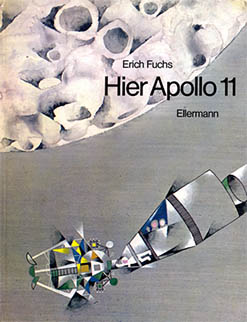
4. For more about Apollo 11 see: Manned Spacecraft Center. Apollo 11 Mission Report. MSC-00171. Nov 1969. For a review of the entire Apollo program see: Johnson Space Center. Apollo Program Summary Report. JSC-09423. Apr 1975. These, as well as many other documents, are available online at the Apollo Surface Journal.
5. NASA itself is an acronym. See what I mean?
20 Jul 2009 ‧ Illustration
